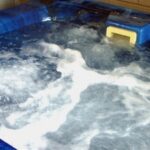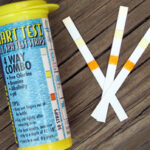We recently purchased a house with an indoor pool sanitized with bromine. With no prior experience maintaining pools I was quickly overwhelmed with the chemistry involved with keeping a pool sanitized and sparkling clean. Three months have passed and thanks to the help of our local pool company and learning from my own mistakes, I’ve become an expert at maintaining our 10,000 gallon pool and I would like to share my findings and experiences with the AC Community.
Why Bromine?
While chlorine is the standard method of sanitizing outdoor pools, bromine, the chemical normally used to sanitize hot tubs because it tends to be more stable in warmer temperatures. According to our local pool company bromine attaches itself to harmful bacteria in a different way than chlorine and it also reacts differently to shock. In a chlorinated pool the chlorine attaches itself to bacteria, dead skin cells, oils, etc and it will no longer protect your pool once the chlorine has attached itself. When shocked with chlorinated shock, the chlorine combined with these bad materials will burn off and once they are filtered through the pump the chlorine levels will be non-existent.
When bromine combines with bacteria, etc., it doesn’t neutralize. The bromine particles attached to the bad particles can still sanitize you pool. Then when you treat your pool with a non-chlorinated shock, only the bad/organic particles are burned off and the old bromine remains in your pool although at a lower level than normal. Your Bromine levels will read as being high because the shock does contain a good amount of bromine. Long story short, when properly brominated and shocked once a week, you wind up using less bromine tablets than if you sanitized with chlorine. A big thank you goes out to Sutcliffe Pools in Port Royal, SC for explaining all of this to me when I first obtained our pool.
Bromine is the better choice for indoor pools for a number of reasons. Though bromine is twice as strong as chlorine, it is almost odorless where chlorine has a strong chemical smell, plus bromine is easier on your eyes and easier on sensitive skin. In an indoor pool room the chlorine vapors can be so intense the fumes can make you dizzy in less than a minute without adequate ventilation. If you happen to have wooden beams in your pool room, bromine won’t rot the wood where chlorine will destroy wood rather quickly. The only downside to bromine is that it is highly corrosive to metals. With good ventilation such as an in-wall fan with louvers, this shouldn’t be a problem. In fact I prefer our large fan to the built-in dehumidifier as the fan whisks away vapor and moisture in seconds where the dehumidifier seems to take forever – not a good thing when it comes to corrosion and mold growth.
Caring for your brominated pool:
Bromine dissolves much slower than Chlorine so one has to be extra vigilant when it comes to the levels in the pool or you could easily wind up with a pool with no sanitizer in it whatsoever if you don’t shock, even with a floating brominator in the pool. The easiest way to maintain your level is to have an automatic brominator, a.k.a. automatic feeder installed in your pump. These brominators hold a fixed amount of tablets and will distribute brominated water when the pump is turned on. Also, always use gloves when handling bromine tablets as bromine is highly corrosive.
We recently purchased a new automatic brominator (otherwise called automatic feeder) and even with it set on the highest setting, it doesn’t keep out bromine at the recommended level so I supplement with granulated bromine. The formula is generally 1 teaspoon per 200 gallons (read the product for specific directions), which is 50 teaspoons for 10,000 gallons. While non-chlorinated shock comes in 1 pound bags (1 pound is used per 10,000 gallons), one pound of regular granulated bromine is more than 50 teaspoons, which is considered regular use. While you can spread out 1 pound of granulated bromine, the levels will remain sky-high for at least 24 hours, where packaged non-chlorinated shock is modified so you can use the pool an hour later in most cases. When shocking your pool pay special attention that you do not buy chlorinated shock or you will create a noxious chemical reaction with the bromine.
Bromine will only be effective if the PH level is between 7.2 and 7.6, so make sure you get the PH under control before adding bromine or non-chlorinated shock to your pool.
Preparing for bromine or shock:
I’ve discovered that maintaining correct levels of PH and alkalinity is a true art form. Balancing the two is tricky but the good news is you can never harm your water to the point of no return. It’s easy to restore correct PH or alkalinity but you will go through some trial and error if a water testing center is not in your area.
The chemicals needed are muriatic acid, preferable in liquid form to lower alkalinity, PH reducer and PH increaser, or plain old baking soda in layman’s terms. Muriatic acid is HCL, or Hydrochloric Acid and lets off horrible gas-chamber-like vapors and can eat through your skin so be sure to wear gloves and have your room as ventilated as possible and wear a respirator. (Notable fact – muriatic acid is also a concrete cleaner and will clean metal stains off of all pools except vinyl. This should be done by an expert due to the fumes and corrosiveness of the acid.) Whatever you do, do not mix these chemicals together or use the same container to measure the chemicals out or you could start a nice little chemical fire. Sometimes when your PH level is too high, you can add PH Decreaser until the cows come home but your PH level will not budge. This means you alkalinity is actually too high. It’s best to have your pool water run through a computer at a pool supply shop but I’ve learned that if my PH and alkalinity are both high I can add no more than 32 oz of Muriatic acid and they will both come down drastically. Any less and not much will happen. Then you will need to add a little PH decreaser (about 6 oz. per 10,000 gallons but check the directions depending on your PH level) and in a half-hour your water will be balanced. Sometimes you might need to come back and add a couple more ounces of increaser but the level should be fine. Once the PH is between 7.2 and 7.6 and your alkalinity is in the normal range according to a pool test strip you can add your bromine or shock. Any other extreme PH level, and the bromine and shock won’t be as effective.
Interesting facts about indoor pools:
*Unless your pool is in a glass-walled sunroom, you won’t have to worry about algae growth or acid rain messing with your chemical levels and water hardness. Your filters, the one next to your skimmer on the pool deck and the one attached to your pump won’t have to be cleaned as often as leaves and other debris will not infiltrate your system. Our biggest concern here in the Southern United States happens to be rather large spiders that are attracted to the seemingly endless drinking source yet meet their demise. There’s nothing quite like reaching your hand into the skimmer filter with a 3-inch dead spider floating around. Even though indoor pools have less debris, it is still a good idea to backwash and then rinse your pump once a week.
*Through personal experience, I’ve noticed that my bromine levels dissipate quicker when my pool heater is constantly on, usually in two days. When the pool is cold the bromine level will stay the same for a week. This is ironic because bromine is known for its stability in hot tubs.
*Surprisingly, maintaining a pool is not as expensive as one would think, especially if you use city water and not well water. Well water contains harsh minerals that quickly stain your pool. In some areas the mineral content is so high that if the pool is not immediately treated with a metal remover, it will cost you hundreds of dollars for professionals to come out, drain your pool and scrub it down with muriatic acid. If you do an initial fill with city water you will never have to drain and refill your pool again.
*Have you ever been to a public pool where the chlorine seemed strong to the point where it burned your eyes? The truth is that the alkalinity was too high. The pool would not have been open to swimmers if the chlorine levels were too high. High alkalinity is a huge problem in public pools due to the large number of swimmers. In your indoor pool, I’ve found that if your alkalinity is high, simply adding a little city water to your pool (usually if the water is less than half-way to the top of your skimmer) will lower the alkalinity all on its own.
* When it comes to testing kits I use both manual kits and test strips. I use the manual kit to get an accurate PH and bromine level and I use my test strip to check for my alkalinity and water hardness (calcium) levels. Pool test strips come in both chlorine and bromine varieties so be sure you acquire the correct type. If you don’t have a pool supply store in your local area I highly recommend www.intheswim.com as they have the cheapest chemicals anywhere and they always have plenty of replacement items and pool toys in stock.
*Lastly, take care when using a pool heater as your electric bill will skyrocket. We have a gas heater and kept out pool heated between 85 and 90 degrees for the first month. When the bill came, the gas amount came to about $630! I’ve since learned that the water will stay relatively warm in an indoor pool for around two days after you turn the heater off, so we’ve been saving money by only turning the heater on about 8 hours before swimming if the pool is at its coldest and about 4 hours if it had been heated in the past few days. We have managed to cut our gas bill in half but we are looking into solar power. While the initial installation will cost around $10,000, it will pay for itself in no time.




